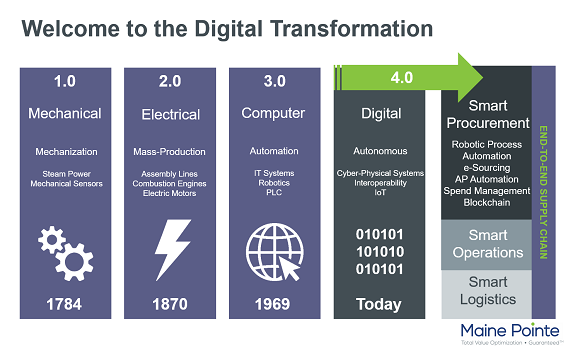Companies are constantly looking for new ways to compete in a challenging, often unpredictable global marketplace. One significant opportunity for enterprises is to capitalize on improving visibility and insights into their end-to-end supply chain. Specifically, companies are aligning center-led procurement operations with financial decisions to see an impact that goes beyond cost reductions.
These is a growing trend for organizations to unlock value by making strategic sourcing and working capital improvements within the boundaries of their existing ERP implementations. This is particularly challenging when an organization's spending is highly obscured, with limited visibility into how the money is spent. A lack of transparency in the data processed from the procure-to pay-cycle, makes it very difficult for companies to understand cost savings opportunities.
Developing a solution that complements an existing ERP architecture, introduces a streamlined process for invoicing and automates spend analytics provides a comprehensive and sustainable view of the organization's procurement health. Such platforms provide advanced data transformation by combining automation and artificial intelligence.
Figure 1

Even with these tools, the only way to assure ongoing improvement is through vigilance and continuous analysis. This requires the organization to not only have the right tools, but also the right processes. In recent years, companies have invested in their technology backbone to improve transactional capabilities.
While large-scale projects, like ERP system implementations or upgrades, still dominate IT investment budgets, investments into data-driven applications are lagging, despite their potential to generate greater returns on investment by improving strategic purchasing capabilities. With the pressure to continuously deliver year-over-year savings and diminishing returns from improving transactional capabilities, procurement needs to improve its digital capabilities to become a full strategic partner in the organization.
How Industry 4.0 is transforming procurement
Service providers in the procurement domain have gone through their own Industry 4.0 transformation equivalent during the past decade, creating a new foundational architecture in the process. The migration from on-premise to cloud technology has unlocked a new era of micro-services supporting a connected web of application programming interfaces.
These micro-services allow apps to seamlessly connect to one another, enabling the easy and seamless exchange of information across applications with no custom coding required. Applications developed for the e-procurement domain have made significant advancements, giving companies the ability to quickly scale and flex as needed. This allows companies the opportunity to remain agnostic to legacy technology and unlock the value, levering a suite of analytical apps that are connected to their transactional data.
Companies seeking a competitive advantage must identify the additional skills, knowledge and tools to address entirely new challenges while solving current ones. Harnessing new technological advancements powered by advancements in IoT, combined with advanced analytics, drives companies to leverage smart data for smart procurement. This new architecture challenges the traditional reservations for investing in data-rich applications. The rise of AI-driven innovation and the increased requirements of industry-specific capabilities are causing big changes in the upstream procurement software market.
One of the biggest advancements, which is foundational to evolve into digitalization, is the area of spend analysis. Creating visibility provides a comprehensive view of the organization's procurement health and behavior while clearly defining actions to improve procurement efficiency, cut costs and maintain a relevant and concise supply base. It addresses key challenges across the entire spectrum of procurement.
What makes analyzing spending complex is ever-increasing data from disparate systems, where maverick transactions can be carried out through a range of mediums such as purchase cards, wire transfers and purchasing platforms, rather than being integrated into payables.
As the unprecedented growth of data continues, it is going to make the procurement function focus more on analytics than ever before. Maine Pointe has already invested in developing a customized platform that provides advanced data transformation by combining automation and artificial intelligence, creating a sustainable, on-demand spend analysis, but this is just the tip of the iceberg. With the help of the Internet of Things (IoT), a new frontier of capabilities such as supplier rationalization, price monitoring, robotic process automation and fraud detection can be tailored to enhance the eco-system of micro-services of procurement.
The question is whether your supply chain ready is ready for this digital transformation?
Nathanael Powrie is Executive Vice President, Data Analytics at Maine Pointe, a global supply chain and operations consulting firm.
SC
MR

More Events
- Next-Gen SupplyChains: Underpinning your ability to manage complexity and drive innovation
- The Future of Supply Chains: Next-Generation Technology and Beyond
- Thanks to all who made NextGen a success
- Medline Executives’ Keynote to Kick Off NextGen Supply Chain Conference
- NextGen Supply Chain Conference 2022: About our event
- Industry Innovators Take Home 2022 NextGen Supply Chain Awards
- More Events
Latest Resources

 Explore
Explore
Topics
Events News
- Next-Gen SupplyChains: Underpinning your ability to manage complexity and drive innovation
- The Future of Supply Chains: Next-Generation Technology and Beyond
- Thanks to all who made NextGen a success
- Medline Executives’ Keynote to Kick Off NextGen Supply Chain Conference
- NextGen Supply Chain Conference 2022: About our event
- Industry Innovators Take Home 2022 NextGen Supply Chain Awards
- More Events
Subscribe

Supply Chain Management Review delivers the best industry content.

Editors’ Picks





